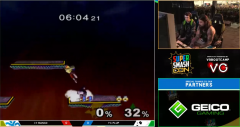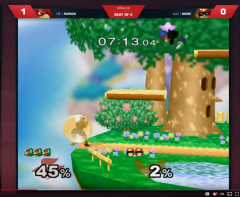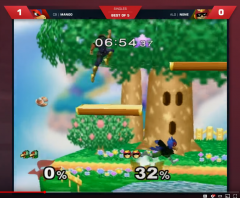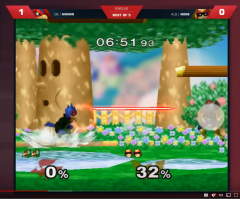1
Can you define opening for me? I would love to add it to my list of ppmd smash definitions.
Is that just a highly advantageous position that you can go in on? People use this word a lot and it makes sense to me but i'd love to hear more about it, if there is any.
I'm very curious about these laser things you plan on showing us.
What do you mean by stalling out dash?
I imagine that's just a foxtrot with a wait on the end.
Would you stall out dashes after lasers or to set up lasers in the first place?
How exactly did you incorporate stalling dashes into laser plays? After you land a laser or before to get an initial laser?
When you say foxtrot forward do you mean you will just do an empty single foxtrot forward, and then decide after you complete the foxtrot to do either a laser in place / dash back laser / etc?
so foxtrot forward > laser in place vs foxtrot forward > dash back laser
Would you do this setup as a start up in neutral or would you do it after you get an initial laser?
It seems like a very delayed timing laser set up if you're doing it after a single laser.
I have actually practiced a setup where I do foxtrot forwards in neutral into laser in place. I find that it works against players who tend to react to dash forward with dash back as it allows me to take space, push them back, and get a laser. If I see them coming in while i'm doing my foxtrot forwards I can always dash back out of it to avoid an attack if I think an attack is coming. Is this similiar to what you're talking about?
You have mentioned wavedash laser many times in the past and i've always been curious, i've practiced them but I don't understand why they would have utility that could be better or more useful than dash lasers. You can turn around laser / jump out at any time during a dash, while wavedash puts you in lag and forces you to wait before lasering.
In particular I find wavedash back laser oos to be useful, but I don't understand the usefulness in neutral compared to dash back laser in place etc. How is the influence wavedash establishes more beneficial in certain spots than dash?
How is wavedash good in general and underused? I have been practicing wavedash of and on for the past few months although I haven't really messed with any set ups involving it aside for the basic dash forward > wavedash back feint. I feel like you're implying you have a bunch of wavedash set ups, could you share some ideas on how it works with other tools?
I've seen you do approaching laser > reverse sh > react with double jump bair when you think foxes are going to jum wlp etc.
Is this what you're talking about or is this reverse sh thing you're talking about at a closer range? I'm getting that vibe. I've seen you also talk about versus falco and fox when landing a close range laser doing dash forward > pivot sh > bair / empty land / dj / dj wl. I have messed with it in practice but no testing yet. Could you tell me lots about this set up? You seem very sold on its usefulness.
This opens another question I have. What is the utility of the dj waveland part of this set up? I understand the mix up between bair, dj bair, but I don't understand the exact utility of the double jump waveland. What does it beat what does it threaten etc. Also, what does the empty land threaten? I still don't really understand empty land well at all. I think I just lack serious understanding of the platform mix up game. I will do some thinking on this.
2
often when i'm practicing shadowboxing / basic tools it takes me along time and mental energy to properly imagine how each of my tools could influence the response and my dealing with it. This is normal right? I often get distracted and just spam the tools kind of zoning out, which is my own fault I know and constitutes "bad practice". I have a question for your specific process though. When you think of a new set up to practice, do you basically imagine scenarios and spacings which could lead up to it working, with each tool influencing a certain action at a certain range in particular, and practice this comprehensively? Even something as simple as approaching laser > turn around sh > bair / empty land / dj wl / dj bair, do you do this and imagine each response and how you would react etc in solo practice for a long time before even considering testing it in a match? I ask because you mentioned how difficult it is to force yourself to notice these things in a match. I find it very difficult to execute my set ups as I would like to, I often commit to a certain combination of actions when I could have reacted and commited to a better action during a dash for example, is this just inadequate preparation / focus in a match? I just want to know exactly how you shadowbox honestly i've seen a lot of your writing on it but it's never very clear how the process goes to me I think. As you've said, you start at the bare basics and their influence and then imagine the combined influence at different ranges and over time you develop the process to where you can practice / imagine complex longer neutral scenarios?
Am I off track here?
Do you ever shadowbox edgeguards? I do this often honestly because it's simpler than the above process with neutral scenarios, in my experience at least. Also i just think edgeguarding is mad important and i'm not good enough at it.
Falco is so hype. That was a great post.
"I know exactly what you're talking about here. In this situation, I either back up a lot to laser, fake a laser to get a counterhit/approach, raw shoot to keep them honest, or just do some type of approach which is also good for keeping them honest. Sometimes, if I think Fox will react to my laser with FH, I will just SH then quickly DJ so I can Dair their Nair. I also may retreating SH so I can DJ Bair if they come in or turnaround laser. Lots to do here but it is pretty awkward."
How does doing some type of approach keep them honest here? If they already full hop i'll get hit I imagine.
How would you fake a laser in this scenario? I think you're talking about doing an approaching laser here to hit their landing and then they double jump and land in your uptilt after. I've seen you do this a lot and I copied it with good success lol, although the laser has to be at a specific timing.
https://youtu.be/9J_xJV0N98U?t=160
Could you talk about this sequence vs fox fh and double jump? I see you and mango do this chase down the fh with laser thing a lot, and honestly i'm confused as to where you'd fit in fh nair in something like unless you read the initial jump.
3
some more simple set up questions. These are the ones that I have been working on for months tbh I think I should move on now.
Can you tell me about slight dash forward > dash back > dash in nair when an opponent is shielding in the corner?
I imagine this is good because the slight dash forward encourages them to hold shield for a bit longer, the dash back lets me see if they roll, and then the dash back influences them to jump oos as they feel safer so then I nair their jump.
Can you tell me about dash back > approaching nair when we're both in neutral? In particular imagine a fox and a marth at threat range not in any specific action at the time.
Can you tell me about dash forward > wavedash back when the opponent is cornered?
What about when you're at threat range versus an opponent and they're shielding?
Can you tell me abuot dash forward > wavedash back > slight dash back?
I've seen you do this one lots but when I test it I find that commiting to the slight dash back seperates me from my ability to cover roll effectively with grounded shine. I don't understand why you would commit to the slight dash and start moving rather than wait for that duration and then commit to an action. It also puts you far away from the opponent, which I don't understand the utility of too well.
Can you tell me about dash forward > dash back > dash forward jump shine waveland onto platform?
I've seen you do this to cover foxes fh waveland.
Also I have a problem with full hopping to hit players when they jump too much. Often when they're semi low percents I full hop nair and they land before I do and I get pressured / hit as a response. When I full hop bair I find myself on a platform that I don't really wanna be on while they're below me. I tend to just wait on the ground for them to come down and try to whiff punish / laser almost always. Is it mainly a percentage / proper use thing that i'm probably struggling with?
Can you tell me more about nairing peoples jump oos as well? I know you do this a lot. I also do this alot, and so does every falco I think, but I don't really have any specific ideas to actually influence a jump oos I just willy nilly nair during some dashes and get hits a lot when people are shielding. I'm thinking some setups are:
when I see them shield and i'm at a medium close range I do slight dash forward > dash back > dash in aerial.
https://youtu.be/gsbhCIIaf04?t=229 here's an example of it but he didn't jump oos he just let go of shield.
When I see them shield and i'm at a very close range I do dash back > dash in nair.
When I see them shield and i'm at a close range I do dash back > dash forward > dash back > nair.
When i'm at a close range I see them shield and do dash forward > dash back ac bair (vs falcon nair mainly).
It just comes down to timing a lot of the times imo, but I know there has to be a better understanding of how to actually influence their jump and recognize that they probably won't roll here. Can you please just talk about this a bit? I see it as a very important thing considering how much people jump oos.
Oops I wrote another long one. Feel free to ignore anything not useful as per usual, the last post was very inspiring, thank you.




